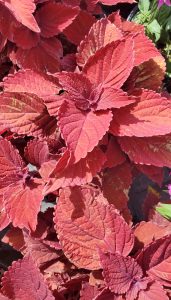
Almost everyone is familiar with coleus – it was one of the first plants that I grew as a child. The coleus has colorful foliage in shades of green, red, pink, yellow, red and maroon. The leaf shape is also very variable as is the ultimate height of individual plants. Coleus has earned its place as a seasonal annual that can be easily propagated and provides an array of new color combinations and leaf types for every taste.
Coleus are very adaptable to either full sun or part shade locations. Keep in mind that too much shade will cause the plants to begin to stretch out. They need well-drained soil amended with organic matter for best results, but are also very well adapted to containers and hanging baskets. Because they can grow tall and leggy and can even produce a spike of bluish flowers, pinching is generally recommended to encourage a bushier, fuller plant. Installed as a mass planting, coleus can be installed on twelve-to-eighteen-inch centers for maximum effect. Coleus are ideal when planted amongst shrubs to give a splash of color in the landscape.
Although listed as an annual, you can easily take cuttings which root incredibly easily continuing a supply of new, fresh plants. Take four-to-six-inch tip cuttings and remove the bottom-most leaves inserting them into sterile potting medium available at any garden center. You can also purchase and grow coleus from seed in mixed colors. If coleus go to flower, the resulting seed will produce many volunteer plants for the next season.
The University of Florida has done a great deal of work to develop new coleus cultivars. Via breeding efforts, tens of thousands of seedlings are grown and analyzed for good characteristics such as new colors, vigorous growth, drought tolerance, etc. A few plants make the cut and become named varieties for commercial production. A few of the UF cultivars have included ‘Big Red Judy™’ which is a large plant with red leaves and adaptation to sun or shade; ‘Frilly Milly™’ with frilly edges and dark red leaves, and ‘Lemon Sunsation™’ with red and chartreuse, lace-like leaves which takes all light conditions.
The world of coleus is yours to explore and collect – it can be addictive. In 2023, rediscover coleus – a recommended Florida-Friendly Landscaping™ plant by the way – and plan to use more in your landscape in years to come! For more information on all types of bedding plants suitable for area, you can also call the Master Gardener Volunteer Helpdesk on Mondays, Wednesdays and Fridays from 1 to 4 pm at 764-4340 for gardening help and insight into their role as an Extension volunteer. Ralph E. Mitchell is the Director/Horticulture Agent for UF/IFAS Extension – Charlotte County. He can be reached at 941-764-4344 or ralph.mitchell@charlottecountyfl.gov . Connect with us on social media. Like us on Facebook @CharlotteCountyExtension and follow us on Instagram @ifascharco.
Resources:
Gilman, E. F. & Howe, T. (2014) Coleus x hybrid Coleus. The University of Florida Extension Service, IFAS.
Gardening Solutions (2020) Coleus. The University of Florida Extension Service, IFAS.
Gardening Solutions (2017) Coleus Cultivars Developed at the University of Florida. The University of Florida Extension Service, IFAS.
Gardening Solutions (2018) UF Graduate Student Develops Thirteen Coleus Varieties. The University of Florida Extension Service, IFAS.
The Florida-Friendly Landscaping Guide to Plant Selection & Landscape Design (2010) The University of Florida Extension Services, IFAS.
 1
1
